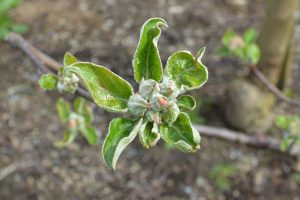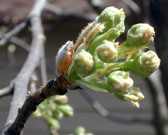Early April has been both cool and rainy. With this kind of weather, we have our thoughts on fungal disease control in the orchards.
One of the greatest challenges to growing apples and pears in our climate is scab, a fungal disease (Venturia inaequalis on apples, Venturia pirina on pears). Preventing this disease is key to keeping your orchard trees healthy.
Some people say, “I don’t mind a few spots on my fruit, why should I spray to prevent this disease?” The short answer is that the infection doesn’t just infect the fruit. More serious is infection on the foliage of your trees, which can cause the leaves to drop early. Serious scab infections can almost defoliate your tree- and its leaves are how the tree gets its energy. Repeated scab infections will stunt your trees, especially young trees.
 Scab infections are dependent on both moisture and temperature. You can see from the table to the left how leaf wetness and temperatures play a role in the leaf infection. The most serious infections occur during warm springs with lots of rain. This spring, we’ve been relatively cool, but we’ve also had lots of hours of leaf wetness. At 54°F, a light scab infection can occur with 11.5 hours of leaf wetness. At 60°F, the same infection can occur after 9.5 hours of leaf wetness. In a commercial orchard, careful monitoring helps the orchardist know when to apply fungicides to prevent infections.
Scab infections are dependent on both moisture and temperature. You can see from the table to the left how leaf wetness and temperatures play a role in the leaf infection. The most serious infections occur during warm springs with lots of rain. This spring, we’ve been relatively cool, but we’ve also had lots of hours of leaf wetness. At 54°F, a light scab infection can occur with 11.5 hours of leaf wetness. At 60°F, the same infection can occur after 9.5 hours of leaf wetness. In a commercial orchard, careful monitoring helps the orchardist know when to apply fungicides to prevent infections.

Apple blossoms at pre-pink stage
Most people growing apples and pears at home want to use organic methods to manage their trees. Currently the best control for scab in the home orchard is micronized sulfur. But sulfur can only prevent infection, not cure it, so it must be on the tree at the critical time! A good strategy is to apply the sulfur just as your

Pear blossoms just separating
apple blossoms are beginning to show color (pre-pink) or your pear blossom clusters are starting to separate. Then apply the sulfur again as the petals fall off the flowers at the end of bloom. These two applications should give you enough control to keep your trees healthy.
What if you can’t spray due to weather? One year’s miss won’t do too much damage, but repeated misses can cause ‘blind wood’ or wood with no fruit buds.
If you don’t want to spray to control scab, choose scab resistant varieties when you plant. There are varieties of both apple and pear that are highly resistant to this fungus.
Other steps you can do to control scab in your orchard:
- Apply lime to the orchard floor in the fall at leaf drop. This both sweetens the soil and helps speed the breakdown of the fallen foliage
- Rake up and destroy fallen foliage to remove scab spores from your orchard
- Keep your trees growing vigorously by avoiding drought stress and fertilizing if necessary

